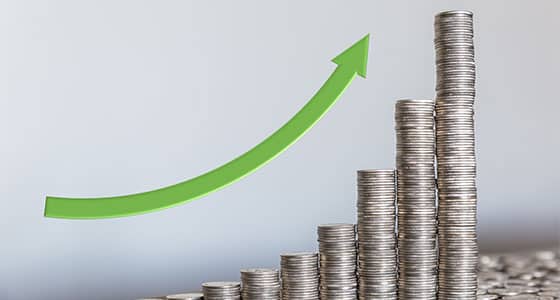Compounding refers to reinvesting interest income at specified intervals to maximise returns. This method increases the principal amount in subsequent intervals, as decided by the bank or financial institution.
A prime example of power of compounding is Fixed Deposits, or FDs. With this investment tool, the interest you receive comes in excess of the interest rate multiplied by the tenure. Thus, Rs.2 Lakhs Fixed Deposit per month interest would be substantial if you keep accumulating it for the long term.
Read on to know what the power of compounding is and its benefits.
Understanding Power of Compounding
Compounding is the annual reinvestment of earnings at the same interest rate to grow the principal amount. This is an intriguing concept because through this method, the interest of your invested money is also earning interest. This is referred to as compound interest. The investment’s value grows at a geometric rate rather than an arithmetic rate. In this way, your principal sum keeps on increasing with each cycle.
Furthermore, investors can utilise this powerful method to calculate their wealth estimation. This would allow them to meet their financial objectives in an easy and hassle-free way. Note that with investment instruments that apply a compounded interest rate, the returns are higher if the money is parked for a longer term.
The best advice to make the best of Rs.2 Lakhs Fixed Deposit per month interest would be to plan finances and start investing early on. An early start will provide you with a higher compounding effect, helping you build substantial wealth over a fixed tenure.

Let us understand the power of compounding with an example:
Suppose you invest Rs.10,000 in an FD for a tenure of 5 years at an interest rate of 9%. In this regard, the interest income you will earn during the first year would be Rs.900, i.e., 9% of 10,000.
Your interest income gets added to your principal amount. Thus, your new principal sum for the second year will become Rs.10,900. Now, the bank will calculate interest on this amount, i.e., 9% of 10,900 = Rs.981. Thus, the principal amount for the third year will amount to Rs. 10,900 + Rs.981 = Rs.11,881.
This method of compounding will continue until the fifth year.
In this regard, note that banks and financial institutions can calculate compound interest on your FD daily, monthly, quarterly, half-yearly or yearly. Consider talking with your bank and understand whether this frequency is flexible or not.
Factors Affecting Power of Compounding
There are a few factors that affect the rate of wealth compounding. Find about them below:
- Rate of compounding
The compounding rate on your investment decides the generation of wealth. For instance, a higher interest rate will churn better returns, since it will increase the interest income you earn in subsequent cycles.
- Investment tenure
The investment tenure is yet another factor that affects your wealth generation. When it comes to FDs, the maximum duration you can keep your money parked is 10 years. However, some banks and financial institutions may offer a higher tenure. Since compounding increases your principal sum over the years, a higher tenure will result in better returns.
- Taxation
When you deposit Rs.2 Lakhs Fixed Deposit, your per month interest becomes liable for taxation. You will have to pay tax if your interest income from FDs is more than Rs.40,000. The limit for senior citizens, in this regard, is kept at Rs.50,000.
As you pay taxes, your overall wealth accumulation rate slightly decreases. However, you can limit your tax outgo by investing in tax saving Fixed Deposit plans. Additionally, if your annual income is less than Rs.2.5 Lakhs you can opt for TDS refund by submitting Form 15H or Form 15G.
Things to Consider to Make Out the Most from Power of Compounding
Mentioned below are a few pointers that will help you make out the most of your FD investments:
- Start early
With a longer investing horizon, you get more time to increase your principal sum. Thus, the overall returns you earn would be on the higher side.
- Choose a shorter compounding cycle
The rate or interval at which the interest multiplies is another fact to consider to maximise your returns. This will help you avail increased interest income. You can use a power of compounding calculator to assess the estimate of returns you might earn considering your principal sum, interest rate and investment tenure.
- Be disciplined
You must first establish your priorities and make disciplined payments if you want to build a strong and successful investment portfolio. In order to maximise your investments, you must try to utilise the power of compounding completely.
It is true that FDs are a high interest low risk investment. However, due diligence is preferred while making a decision. In this regard, you can visit a diversified platform like Bajaj MARKETS to compare between different FD plans.
Evidently, your Rs.2 Lakhs Fixed Deposit per month interest would increase significantly through the power of compounding. However, consider going through the interest rate the bank offers to make the most out of your returns.